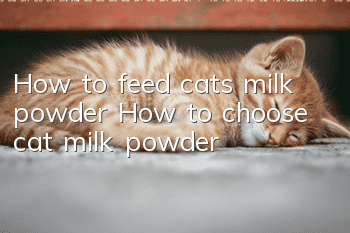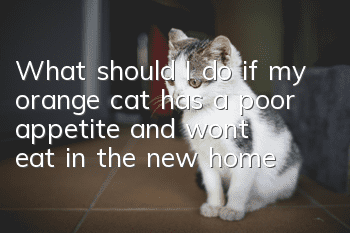How to feed cats milk powder? How to choose cat milk powder?

How to identify the quality of a milk powder: Hold the packaging bag with your hands and rub it back and forth. Good milk powder will make a "squeaking" sound. The color of good milk powder is natural milk yellow. Good milk powder has a frankincense and natural fragrance. Take a little milk powder and put it into your mouth to taste. Good milk powder is delicate and sticky, easy to stick to teeth and tongue, and does not have the sweetness of sugar.
How to identify the quality of a milk powder?
Test the feel: If it is bagged milk powder, hold the bag with your hands and rub it back and forth. Good milk powder will make a "squeaking" sound; inferior milk powder will have relatively thick particles due to the addition of glucose and will make a "swirling" sound. flowing sound.
Look at the color: The color of a good milk powder is naturally milky yellow. If you look closely, the color of inferior milk powder will be crystallized and shiny, or it will be bleached.
Smell: Good milk powder has a frankincense and natural fragrance, while inferior milk powder has no frankincense or a strong frankincense (usually with added cream).
Taste: Take a small amount of milk powder and put it into your mouth to taste. Good milk powder is delicate and sticky, easy to stick to teeth and tongue, and has no sugary sweetness; inferior milk powder dissolves quickly in the mouth, does not stick to teeth, and has a strong sweetness.
Look at the dissolution speed: Put the milk powder into a cup of water. The faster it dissolves, the greater the possibility of inferior milk powder. When washed with hot boiling water, good milk powder will form suspended matter and float up. It will stick to the spoon at the beginning of stirring and will stick to the wall after being left for a long time. Inferior milk powder dissolves quickly because it is likely to contain co-solvents.
Feeding methods
No matter which feeding method you use, you must be careful not to let the milk flow into the kitten's lungs. We can choose to hold the kitten's belly with our hands, keep it in a prone position, slightly raise its head, and aim the pacifier head at the kitten's mouth at a 45-degree angle. Do not squeeze the bottle and allow the kitten to eat at its own speed, otherwise the milk powder will flow into the kitten's mouth too quickly and cause it to choke.
1. Feed with a spoon
This method of feeding will be very slow and requires patience. We slowly pour the milk from the spoon into the kitten's mouth. We should not pour it too fast to prevent the milk from flowing into the kitten's lungs. Don't raise the kitten's head too high, otherwise it will feed into the lungs. This method is suitable for kittens who are weak and cannot suck milk on their own.
2. Use a syringe to drip milk
This method is similar to spoon feeding, which is cleaner and faster to feed. Fill the syringe with the amount of milk for each feeding, put it in the kitten's mouth, and drop one drop at a time so that the kitten can swallow it easily without choking. If the kitten knows that milk comes out of a syringeIf it comes, it may start sucking on the needle and suck out the milk on its own. At this time, it is recommended that you switch to feeding it with a bottle.
3. Use bottle feeding
Generally, kittens that can suck milk like to use a bottle, which is also a more natural way of feeding. The size of the hole on the nipple is important. You need to cut a hole yourself. The size of the hole should be such that only one drop of milk can drip out at a time. If the nipple hole is too large, milk will flow directly through the hole, which may cause the kitten to suck milk into its lungs when sucking. If you have to squeeze the bottle to let the milk flow out, then the milk hole is too small, which will make the kitten have a hard time eating, and may also cause the kitten not to eat enough.
4. Tube feeding
This method is the easiest, cleanest, and fastest, but it also requires suitable tools and skilled skills to avoid pouring milk into the lungs. After each feeding, it is best to wipe the kitten's mouth with a warm wet tissue to wipe away the leaked milk. Don't feed too much at once, especially in the beginning. After feeding, use your hands or a dry towel to imitate the mother cat's licking action to massage the kitten's body, or gently pat the side of the kitten until it burps.
What should we pay attention to when feeding milk powder?
It is not suitable to feed goat milk powder for human consumption: Goat milk powder for human consumption is proportioned according to human standards and is quite different from cat milk powder. Eating human milk powder may cause kittens to be unable to digest it well. And the absorption of certain fats and proteins will cause intolerance symptoms, such as diarrhea, vomiting and other gastrointestinal diseases. Therefore, it is not recommended that parents choose goat milk powder for human consumption. They should prepare goat milk powder for cats at home.
Determine a reasonable feeding time: Kittens are generally fed every three hours, which is eight times a day. If you feed the kitten too frequently, the milk in the kitten's stomach cannot be emptied, which will cause the milk to ferment and cause flatulence, which will burden the kitten's gastrointestinal tract and cause gastrointestinal diseases.
Control the feeding amount: Generally, it mainly depends on the cat’s feed intake. You can also feed according to the feeding amount recommended by the manufacturer. Lactating kittens should add an appropriate amount according to their different body shapes, and gradually increase the amount as their weight increases. It is recommended to take it once every 3 hours from 1 to 21 days, with no more than 200ml throughout the day; once every 3-4 hours from 21 to 35 days, with no more than 400ml throughout the day. Generally, 40ml of warm water should be used for every 5g of milk powder. In order not to destroy the nutritional content of goat milk powder, it is recommended to brew it with 2/3 warm water (60-80℃), then add another 1/3 warm water to dissolve, and wait until the temperature drops to 40℃. Feed again below.
- Why does the kitten keep sneezing?
- How do cats communicate with each other?
- Cat vomited a puddle of yellow water after eating cat grass
- Nutritional needs of healthy cats
- Two ways to measure the temperature of pet cats
- Why does the cat meow when the owner takes a bath?
- Can cats eat chicken liver?
- Why can’t Cat Howl Spring be interrupted?
- Will the color of lanugo change after gold gradient layer change?
- Will Ragdoll cats be lonely at home alone?



